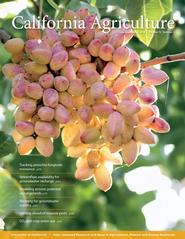All Issues

Pistachio cluster on tree, Colusa County (see article). Photo by Evett Kilmartin.
Matteo Garbelotto introduces the California Agriculture issue on phytophthora contamination of ecological restoration sites.
Volume 72, Number 3
News and opinion
Proactive biocontrol could accelerate responses to invasive pests in urban areas — where pesticide use may be unpopular — before they spread to agricultural areas.
Restoring habitat in retired farmland could reduce water demand and provide ecosystem services for farmers and local communities.
Understanding the mechanisms involved in plants' response to rising CO2 levels may lead to the development of crop plant varieties better adapted to future drought conditions.
Briefs on recent articles on grafted tomatoes, avocado ripening, fresh produce in low-income neighborhoods, a dystopic novel and more.





